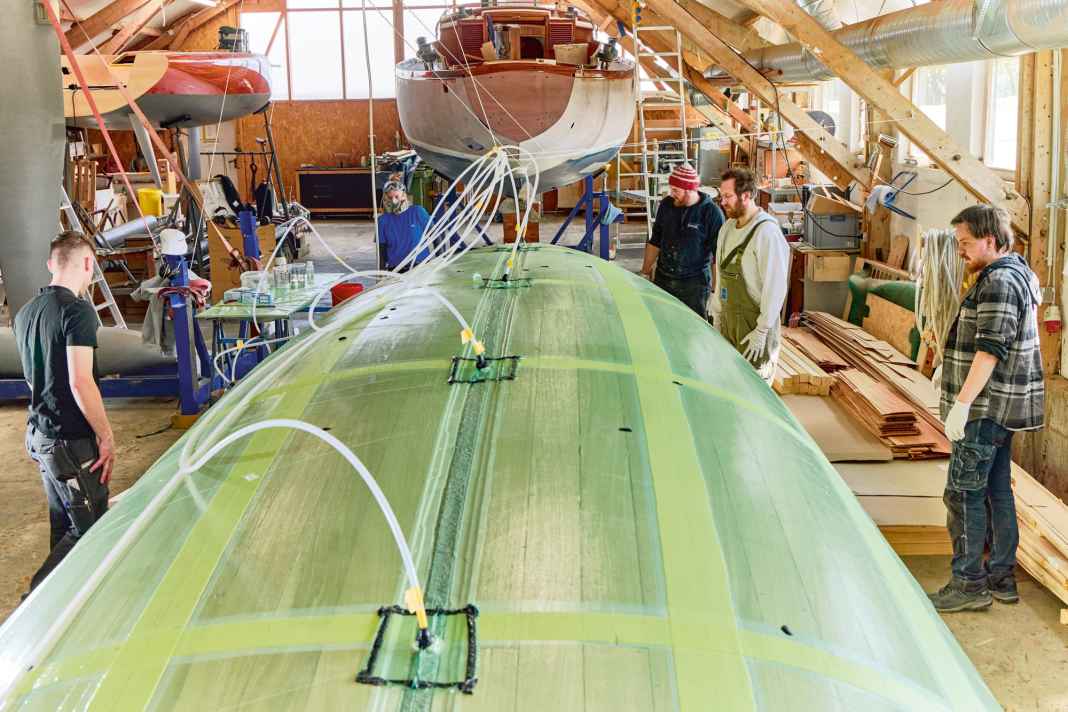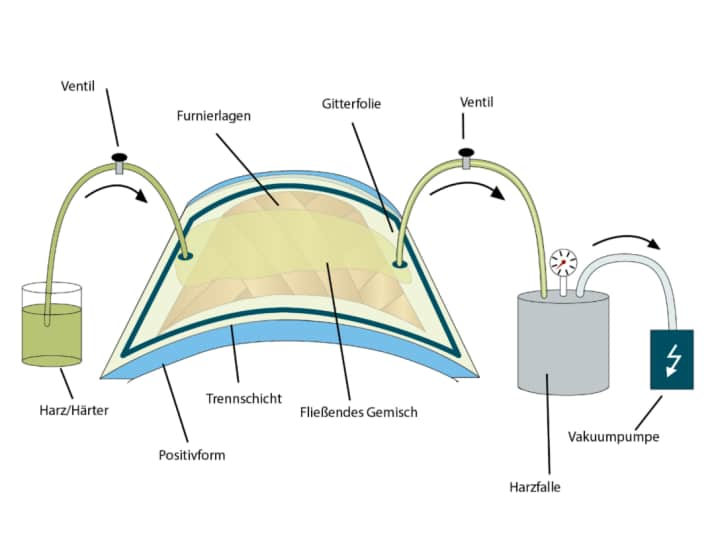





There are inventions and innovations that make even experts wonder why they or someone else didn't think of them long ago. Things that are actually obvious. In boat design, these include wide hulls with barely tapered sterns that are stiffer and offer more space at the same time. Or rigs with heavily swept-back spreaders that make backstays superfluous. Or self-tailing winches that are easier to operate.
Also interesting:
The examples are countless. And the list has now been enriched by a boat-building innovation. It doesn't come from a garage like many major inventions such as the Apple computer, nor from a cowshed like the legendary, style-defining X-79, but a simple, draughty chicken farm on the Schlei is certainly a comparable birthplace. Königstein 8a, to be precise, is closer to Arnis than to Kappeln: inconspicuous halls, an office container and a manageable outdoor area with a view of the beautiful estuary make up Jan Brügge Bootsbau GmbH or the Königstein shipyard.
A company that joins the group of shipyards operating at the highest level of craftsmanship that make the upper Schlei region the Dorado of German boatbuilding. Yachts based on designs by Sparkman & Stephens or the German designers Miglitsch, Böhling and Oehlmann were built there decades ago.
In addition to Jan Brügge, older established manufacturers such as Henningsen & Steckmest, Yacht- & Bootswerft Stapelfeldt, Yachtbau Janssen & Renkhoff and formerly Matthiessen & Paulsen also manufacture there in Angeln. All of them specialise in one-off constructions or small series, preferably made of or with lots of wood. There are also numerous service companies in the region, such as engine workshops, sailmakers or yacht designers as well as boat dealers, all united in the strong Schleiboot industry association. The association makes its catchment area probably the strongest boatbuilding nucleus in Germany alongside the more geographically dispersed Lake Constance scene.
The wood infusion method

The process is similar to vacuum infusion for plastic yachts. The construction material made of scrims or wood veneers, possibly combined with a sandwich core of balsa wood or foam, is positioned on the construction mould. It lies on a separating layer and is covered on the outside with a mesh fabric and then with a vacuum film. A vacuum pump draws the smoothly formulated epoxy resin-hardener mixture from a container through the materials, while the vacuum film presses the wooden layers (or the scrims) together.
Jan Brügge experiments
Wood is traditionally the most important material in the core areas of boat manufacturing in the south and north of Germany. Decks or complete boats are built using various methods
processes, from traditional construction methods to tried-and-tested moulded gluing and strip construction in its various designs.
In recent years, the aforementioned Jan Brügge has been at his most experimental and exposed. The shipyard was established in 2016 directly after Brügge gained his master craftsman's title, having learnt his trade from Willy Stapelfeldt in nearby Kappeln, from the merger of a handful of young boatbuilders who wanted to share their expertise as well as machinery and premises. In addition to Jan Brügge Bootsbau GmbH with around 20 employees, three other boatbuilders work at the shipyard.
After several repairs, conversions and refits, the first major project was launched in Königstein in 2022: the 48-foot cruiser-racer "Elida". The project was the result of international
collaboration: the design was created by Frenchman Thomas Tison. The hull was created in Bruges from four moulded layers of spruce and a thin horizontal layer of mahogany to finish. A layer of carbon was added as reinforcement. The carbon sandwich deck was made at Multiplast in Brittany, one of the top addresses for hot offshore racers such as Imocas and Ultiums.
The overall result: one of the most beautiful, if not the most beautiful boat in northern Germany, if you love modern shapes in perfection and wood.
Contemporary wooden daysailer: Woy 26
The ambitious "Elida" was not a one-off. It was followed last year by the Woy 26 a smaller, but just as consistently independent and modern ship. The Woy, which stands for wooden yachts, is a contemporary daysailer made from local timber. The design and construction material represent the other side of the designer Martin Menzner, who is primarily known for aluminium explorers such as the BM series or the deck saloon yachts from the new Pure Yachts shipyard in Kiel, but also for beautiful wooden yachts such as the LA 28 (YACHT 1/2016) or the twelve metre long single building "Klippeneck" from Lake Constance is known.
Martin Menzner sees wood as the most archetypal and natural material for boats: "It touches all the senses, arouses emotions, is sustainable, durable and timeless, which is why wood is ideal for modern boats. An appropriate design in combination with the oldest boat building material also creates a special appeal."
Sustainability meets modern production in yacht building
However, wood plays a subordinate role as a building material for high-performance keel yachts these days. Nevertheless, RM from France builds some of its hulls from plywood, minis and self-build boats such as the Globe 5.80 are also made from the material, and Marc Thiercelin wants to launch an Imoca made from wood, bamboo and hemp for the next Vendée.
"But," says Jan Brügge, "little has happened in wooden boat construction in recent years. I was therefore looking for a modern production method for this traditional material." Brügge came into contact with the Eberswalde University for Sustainable Development (HNE) via the Maritime Cluster Northern Germany (MCN), a network that usually brings together members of the commercial shipping industry. They are launching the project with the unwieldy title "Boats made from bio-based materials: developing new composite materials and production techniques to increase efficiency in bio-based boat and yacht construction".
MCN project manager Dr Sonja Endres: "We are happy to support the project as it progresses. The use of sustainable materials and production methods in boat building has been on our minds for a long time. The time is ripe for a production-ready, sustainable sports boat that is in no way inferior to conventional boats in terms of performance and sailing fun." The result of the collaboration is called Holz-Infusion and is patent pending.
Premiere of the wood infusion
Local date. A sunny Wednesday in April. A few sailors are already populating the Schlei, the rapeseed is beginning to bloom, cows are lying in the grass in front of the shipyard, which is bustling with activity. A major première, the first complete hull is to be infused. Brügge, the Königstein boatbuilders and their partners from Eberswalde had practised time and again on test pieces, varying the method and preparing the workpieces in different ways.
"I was looking for a method to combine wooden boat building with modern techniques. The solution is called wood fusion." Jan Brügge
Today it's all about the big picture. There is a certain self-confidence, nobody seems to have any major doubts about success, which is also reflected in the fact that YACHT is able to attend the premiere. Failure is obviously not an option.
In the hall, characteristically between an old conventionally planked seagoing cruiser and construction number 1 of the ultra-modern Woy 26, the hull under construction of construction number 2 lies upside down on the positive mould milled at Knierim in Kiel. This is already a novelty; the mould helps with the dimensional accuracy of the Woy, which is ultimately to be produced as a small series. Wooden hulls are usually created using auxiliary frames. The observer sees strips of wood moulded into the shape of a boat, a transparent film, various hoses that end in a metal cylinder, canisters of resin and hardener.
40 to 50 kilograms of resin
Jan Brügge explains: "We suck the resin-hardener mixture out of the red container here with a pump under the vacuum mat and through the wood at a vacuum of just under one bar. The wood is completely soaked in the process." The layered structure of the fuselage consists of four layers of wooden strips made from local larch, each 2.5 millimetres thick. These are laid diagonally and offset to each other and provisionally stapled, says the ambitious, youthful-looking master boat builder.
And off we go. A boat builder mixes the bio-based components of the epoxy formulated for good flowability and pours the container into the tank, from which a handful of hoses lead into the vacuum mat, the pump is started, a vacuum is built up, clamps and distributors are opened and the system slowly but steadily sucks the resin-hardener mixture through the layers of wood. The key feature is the fine grooves on the underside of the wooden layers. The boat builders have milled the millimetre-sized grooves into the veneers, allowing the mixture to flow through these and the edges of the wooden strips and saturate the entire material structure from the inside to the outside.
The hull of the Woy 26 will hold around 40 to 50 kilograms of resin. The whole process takes about one and a half hours in one shot. The boat builders control the even flow of the resin, which they can control with clamps on the various hoses.
Efficient and environmentally friendly yacht production
A major effort, but one that pays off. The result is a wooden hull impregnated with epoxy resin, just like a conventionally mould-glued one. However, the shipyard can save intermediate steps and does not have to coat each layer individually with resin, position it and treat it with a vacuum. This saves time and material. What's more, the use of resin is more controllable and emissions can be extremely reduced thanks to the almost completely closed system.
Other environmentally friendly aspects of the wood infusion method: the one-off vacuum process produces less waste compared to conventional mould gluing. Neither teak nor mahogany are used, but only larch and silver fir in the case of the Woy.
"We don't have to treat each layer individually, the hull is completely impregnated in one shot. That saves time and money" Jan Brügge
Once the wood is completely soaked and hardened, the film is removed and the hull is tempered in a tent at 55 degrees. The boat builders then fill and sand the hull. It is braced with frames and married to the deck. The hull is laminated or given a layer of thinner wood, which is painted, but this does not suit the Woy, says Jan Brügge. The deck, with its more heterogeneous shape and tighter radii, the complicated component, is also created using the new process.
The patent-pending method is similar to the vacuum infusion of hulls in GRP boat construction, which is also used in large-scale production. However, due to the material, it is easier to suck the resin mixture homogeneously through the laminate structure, as the fabric and scrims offer more cavities and thus natural paths for the flow.
In both cases, the shipyards achieve the same goals with the infusion method: They produce homogeneously structured, clean parts with a controlled resin content and no air pockets. The hulls are stiff, durable, light and easy to maintain. As a result, wooden and plastic yachts are more similar than ever.

